The cultural heritage and history
The Cultural Heritage of the Magura National Park
The Magura National Park with its buffer zone is a very interesting area considering its ethnographic and historical values.
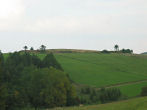 The oldest trace of human presence in this part of the Beskid Niski Mts. are the remains of a large castle in Brzezowa village, situated among the fields of Walik hill at the foot of Magura Wątkowaska Mt. (the Park’s buffer zone). According to the historians, it used to be a part of a chain of early medieval castles from the 9th -10th century. In the area of about 4 ha the remains of clay- wooden houses and pieces of ceramics from the end of the 8th century were discovered. On Zamkowa Gora Mt. near Mrukowa village some fragments of a medieval stone fort from 14th- 15th century were also preserved.
The oldest trace of human presence in this part of the Beskid Niski Mts. are the remains of a large castle in Brzezowa village, situated among the fields of Walik hill at the foot of Magura Wątkowaska Mt. (the Park’s buffer zone). According to the historians, it used to be a part of a chain of early medieval castles from the 9th -10th century. In the area of about 4 ha the remains of clay- wooden houses and pieces of ceramics from the end of the 8th century were discovered. On Zamkowa Gora Mt. near Mrukowa village some fragments of a medieval stone fort from 14th- 15th century were also preserved.
This area, as every borderline, was a place where different nations and their cultures were merging which resulted in its present cultural value. Some monuments of sacred architecture of the West- Lemko style may be admired: wooden Greek Catholic churches in Krempna, Kotan, Bartne, Wolowiec, Pielgrzymka, Swiatkowa Wielka and Swiatkowa Mala villages.
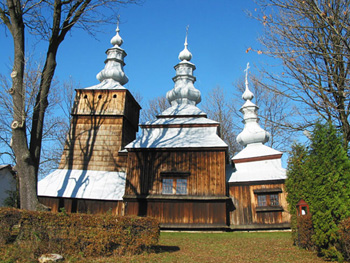
Orthodox Church in Krempna (phot. Slawomir Basista)
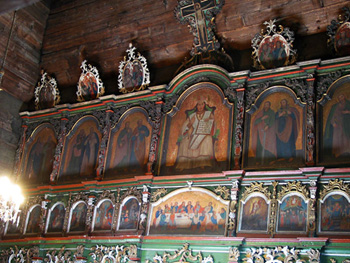
The interior of the Ortodox Church in Krempna (phot. Slawomir Basista)
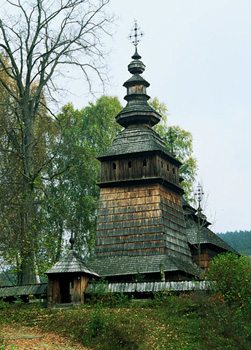
Orthodox Church in Kotan (phot. Andrzej Czaderna)
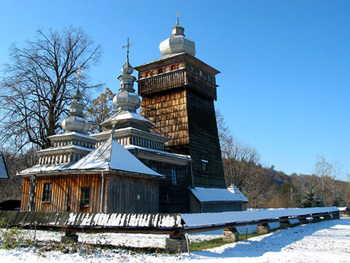
Orthodox Church in Swiatkowa Wielka (phot. Slawomir Basista )
Numerous roadside shrines, stone crosses and roadside figures made of local sandstone by the indigenous stonemasons may also attract tourist’s attention. In some villages original Lemko cottages, so-called “chyze”, combining the living area and space for animals and crops under one roof, may also be found.
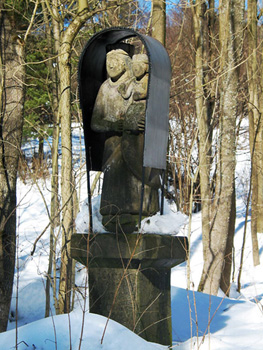
Figure of Saint Family in Swierzowa Ruska (phot. Andrzej Czaderna)
Typically Polish villages – Huta Krempska, Huta Pielgrzymska, Huta Polanska, were also very important in the history and culture of this region as up until 19th century they were related to the glasswork industry (huta – glasswork). In Huta Polanska there is also a small stone catholic church destroyed during the World War II and rebuilt between 1991-95.
Military cemeteries from World War I built between 1915-1918 are a quite distinct group of monuments. These cemeteries may provoke reflection as soldiers buried there, who used to be enemies, now lay there shoulder to shoulder, reconciled. The way they were designed and integrated into the landscape of the Beskid Niski Mts. is worthy of recognition and admiration. In the park’s surroundings cemeteries in Krempna, Grab, Czarne and Wola Cieklinska deserve special attention.
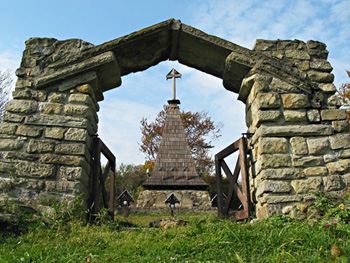
Military cemetery in Grab (phot. Slawomir Basista )
A tragic memento of World War II is the collective tomb of 1250 Jewish people exterminated by the Nazis in 1942 near the Halbow col.


